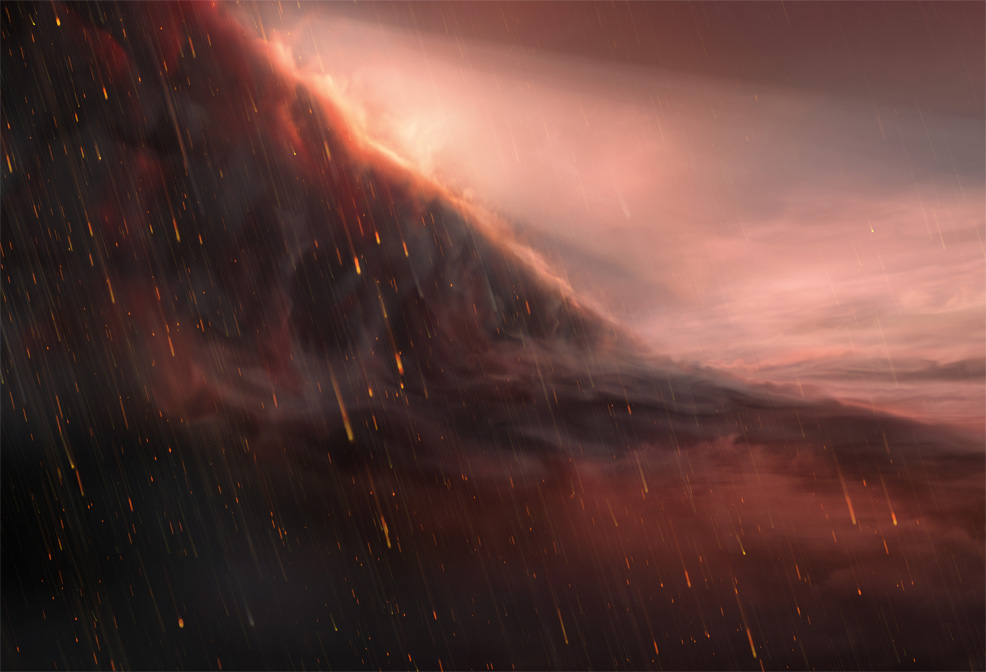
12th March 2020 Astronomers find exoplanet where it rains molten iron Researchers using ESO's Very Large Telescope (VLT) report the discovery of WASP-76b, an exoplanet so hot that it rains molten iron.
An ultra-hot, giant exoplanet – named yesterday as WASP-76b – exists in a system located 640 light years away. The newly revealed world is tidally locked – meaning that one hemisphere permanently faces the star, like the Moon as it travels around the Earth. At 4.5 million km (2.8 million miles), the orbital distance between it and its parent star is just 6% of the gap between our Sun and Mercury at perihelion. On its dayside, the planet receives thousands of times more radiation from its star than the Earth does from our Sun. At 2,400°C (4,352°F), conditions are so hellishly hot that molecules separate into atoms, and metals like iron simply evaporate into the atmosphere. The extreme difference between day and night sides results in winds of almost unimaginable ferocity – blowing iron vapour at 10,000 mph (16,100 km/h) to the cooler night side, where temperatures decrease to around 1,500°C (2,730°F). Here, the iron condenses into droplets. Not only does WASP-76b have different day-night temperatures, it also has a distinct day-night chemistry, according to a detailed study published yesterday by the astronomers. Using the powerful new ESPRESSO instrument on ESO's Very Large Telescope (VLT) in the Chilean Atacama Desert, the team identified, for the first time, chemical variations on a so-called hot Jupiter class of planet. They detected a strong signature of iron vapour at the "evening" border (seen in the artist's impression above), which separates the planet's dayside from its night side. "Surprisingly, however, we do not see the iron vapour in the morning," says David Ehrenreich, Associate Professor in the Department of Astronomy at the University of Geneva, Switzerland, who led the study. "It is only raining iron on the night side of this extreme exoplanet," he adds.
"The observations show that iron vapour is abundant in the atmosphere of the hot day side of WASP-76b," explains María Rosa Zapatero Osorio, an astrophysicist at the Centre for Astrobiology in Madrid, Spain, and chair of the ESPRESSO science team. "A fraction of this iron is injected into the night side owing to the planet's rotation and atmospheric winds. There, the iron encounters much cooler environments, condenses and rains down." ESPRESSO – which stands for Echelle SPectrograph for Rocky Exoplanets and Stable Spectroscopic Observations – was originally designed to hunt for Earth-like planets around Sun-like stars. However, it has proven to be much more versatile. "We soon realised that the remarkable collecting power of the VLT and extreme stability of ESPRESSO made it a prime machine to study exoplanet atmospheres," says Pedro Figueira, ESPRESSO instrument scientist at ESO in Chile. "What we have now is a whole new way to trace the climate of the most extreme exoplanets," concludes Ehrenreich. "Extreme" is certainly the right word to describe WASP-76b. Its conditions are unlike anything seen in our Solar System and its temperature is five times hotter than the mean average on Venus. The fictional planet of Crematoria – depicted in the 2004 sci-fi adventure, The Chronicles of Riddick – would seem relatively chilly by comparison, with a day temperature of "only" 372°C (702°F), according to its wiki page.
Comments »
If you enjoyed this article, please consider sharing it:
|







